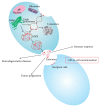Exosomes and Their Therapeutic Potentials of Stem Cells
- PMID: 26770213
- PMCID: PMC4684885
- DOI: 10.1155/2016/7653489
Exosomes and Their Therapeutic Potentials of Stem Cells
Abstract
Exosomes, a group of vesicles originating from the multivesicular bodies (MVBs), are released into the extracellular space when MVBs fuse with the plasma membrane. Numerous studies indicate that exosomes play important roles in cell-to-cell communication, and exosomes from specific cell types and conditions display multiple functions such as exerting positive effects on regeneration in many tissues. It is widely accepted that the therapeutic potential of stem cells may be mediated largely by the paracrine factors, so harnessing the paracrine effects of stem and progenitor cells without affecting these living, replicating, and potentially pluripotent cell populations is an advantage in terms of safety and complexity. Ascending evidence indicated that exosomes might be the main components of paracrine factors; thus, understanding the role of exosomes in each subtype of stem cells is far-reaching. In this review, we discuss the functions of exosomes from different types of stem cells and emphasize the therapeutic potentials of exosomes, providing an alternative way of developing strategies to cure diseases.
Figures


References
-
- Ghita A., Pascut F. C., Sottile V., Denning C., Notingher I. Applications of Raman micro-spectroscopy to stem cell technology: label-free molecular discrimination and monitoring cell differentiation. EPJ Techniques and Instrumentation. 2015;2(1):p. 6. doi: 10.1140/epjti/s40485-015-0016-8. - DOI - PMC - PubMed
Publication types
LinkOut - more resources
Full Text Sources
Other Literature Sources

